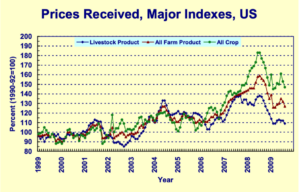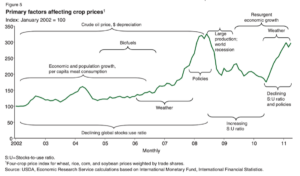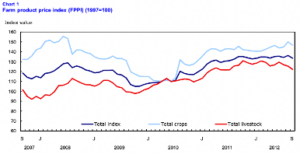Harvesting Insights: Leveraging Non-ag Markets for Crop Value and Strategy
March 11, 2024
By now, all producers have experienced the effects of inflation. When it comes to the financial management of your farm and business, it’s important to think not only about grain market outlooks and prices, but also about how external non-agricultural markets and macroeconomic headwinds (or tailwinds) will impact the agricultural industry now and in the future.
Grain Markets Are Not the Only Markets that Affect a Farm’s Operation
So how can the value of all producers’ crops shift due to changes in broader economic activity? We live in a connected world, where many factors can affect farm income: energy prices, economic growth and decay, foreign exchange rates, and more.
Here’s why looking at the bigger picture is important for every producer — and how GrainFox can make it easier for producers to stay up to date on economic trends, allowing for more informed strategic planning and decision making.
The Connection Between Grain Farm Operations and External Markets
Despite the constant need for food, animal feed, and agricultural products for myriad other uses, the ag industry has never been immune to the ebb and flow (and sometimes violent torrent) of the economy at large.
Here are a few recent examples of non-ag markets having a significant impact on the ag industry:
The Crude Oil Upswing and Ethanol Boom of 2006-2008
In 2006, the average annual OPEC crude oil price reached over $50 USD to a new all-time high. Thanks to this increase, it made financial sense to use grain to make fuel, which helped spark the ethanol boom to which the US Government further contributed by subsidizing the use of corn for ethanol.
By the end of 2007, the price of corn reached $157 USD per metric ton. In the United States, an additional 6.25 million hectares of corn was planted in 2007 due to this price increase, which led to reduced soybean crops and increased soybean prices. Grains did follow crude, with massive bull markets of their own, in late 2007 and 2008.
The Financial Crisis of the Late 2000s
The financial meltdown of late 2008 and early 2009 caused several commodities, including crops, to decline. During recessions, consumer behaviour changes and some products, such as animal protein, see reduced consumption. This reduction in demand drives lower demand for feed, such as corn, and causes the commodity price to decrease. Agricultural commodity prices decreased during this time, compared with those in early 2008.

Source: National Agricultural Statistics Service
The Recovery of 2010-2013
There are several long-term and short-term factors that led to the economic recovery of 2010-2013. Long-term factors included global growth in population and incomes, increased consumption of animal products, depreciation of the US dollar, rising energy prices, and slower growth in agricultural productivity.
Short-term factors included weather-related ag production shortfalls, a decline in world stocks of grains and oilseeds, and changes in trade policies and practices. The enactment of the financial stabilization bill and the American Recovery and Reinvestment Act in the United States further contributed.
The graph below summarizes the primary factors affecting crop prices in the United States from 2002 to 2011:

Source: United States Department of Agriculture
We can see how the economic conditions of the late 2000s affected Canadian crop prices from 2007 to September 2012 in the graph below:

Source: Statistics Canada
The COVID-19 Pandemic
The impacts from COVID-19 are vast and ever-present. Halts in production, supply chain disruptions, and lack of global economic stability are some of the major implications every industry faced, including the agricultural industry. For example, stoppage of production and delivery of fertilizer caused a massive spike in price from 2020 to 2021. The impact of the pandemic is far-reaching, and no one knows how long its ripple effects will last.
Producers, like other business operators, are impacted by national and global macroeconomic events and need to look beyond their own markets to be resistant to economic shifts. A better understanding of what is happening on a broader scale is critical.


